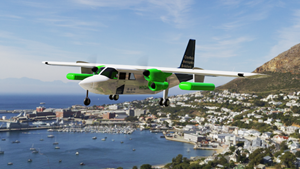News
Cranfield Aerospace Solutions to convert Britten-Norman Islander aircraft to H2 propulsion
Cranfield Aerospace Solutions is converting a conventional Britten-Norman Islander aircraft to H2 propulsion (Project Fresson). The aircraft will demonstrate the viability of H2 aircraft technology as a solution to aviation’s sustainability challenges.
The demonstrator aircraft is set to begin a test flight program in 2024, with the view to certifying the H2 version of the world-famous Islander for commercial entry into service in 2026.
Having carried out baseline flight tests of G-HYUK – the unmodified Islander which will be used as the demonstrator aircraft, Cranfield Aerospace will next year use the aircraft as a flying testbed for its H2 fuel-cell propulsion system (HFCPS).
The demonstrator aircraft will be converted by replacing one of its two piston engines with the HFCPS, which will generate 240 kW of electrical power and produce up to 220 kW from the motor.
“The CAeS propulsion system design does not include batteries for transient power needs such as a go-around due to the fact that we have sized the H2 fuel-cell system, so no battery energy storage is required and the HFCS power output is controlled directly to achieve the necessary responsiveness and stability without a buffer energy store,” said Director of Engineering at CAes, Rob Marsh.
The technology demonstrator is a significant step toward the production solution as the Islander’s HFCS and election propulsion unit, which includes the motor and inverter will be packaged into the nacelle in a representative way to what the 2026 product will be.
Heat challenges. Removing the heat that a HFCS produces is one of the key challenges. CAeS’ demonstrator will have two reaction engine heat exchangers mounted underneath the converted nacelle, sized to reject the full amount of heat produced.
Not representative of the production solution, the design will be optimized into a smaller configuration more akin to the existing air intake for the production version.
The larger than production version heat exchangers also pose a drag issue for the demonstrator H2 aircraft, and as such the aircraft will house the pressurized gaseous H2 fuel tank inside the fuselage. As displayed in the H2 Islander render, the production version will mount the H2 tanks externally on the underside of the aircraft’s wing.
To develop the demonstrator CAeS has collaborated with UK companies Ricardo for the fuel-cell system, Evolito the electric motor and Reaction Engines the heat exchanger. The H2 Islander aircraft product will have fully optimized zero-carbon technology which will allow the aircraft to carry out many of the missions it fulfils today in its conventional hydrocarbon form and open up new opportunities for regional connectivity and supercomputer services in urban areas.
The product, which will have capacity for 6-8 passengers, will carry out missions such as connecting remote communities, commuting and tourist flights can also be configured for cargo purposes.
With a 60-minute flight endurance plus a 45-minute reserve, the product H2 Islander has a 200-km range plus reserve. The zero-carbon version will also benefit from a noise reduction and less vibration, enhancing the passenger experience on the Islander



